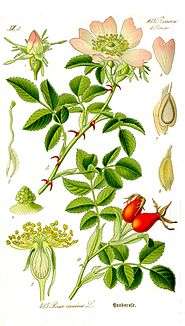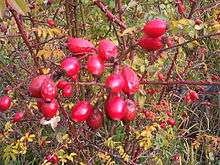Rosa canina
| Rosa canina | |
|---|---|
 | |
| Rosa canina flowers are sometimes pink | |
| Scientific classification | |
| Kingdom: | Plantae |
| (unranked): | Angiosperms |
| (unranked): | Eudicots |
| (unranked): | Rosids |
| Order: | Rosales |
| Family: | Rosaceae |
| Genus: | Rosa |
| Species: | R. canina |
| Binomial name | |
| Rosa canina | |
| Synonyms | |
|
See text | |
Rosa canina, commonly known as the dog rose,[1] is a variable climbing, wild rose species native to Europe, northwest Africa, and western Asia.
It is a deciduous shrub normally ranging in height from 1–5 metres (3.3–16.4 ft), though sometimes it can scramble higher into the crowns of taller trees. Its stems are covered with small, sharp, hooked prickles, which aid it in climbing. The leaves are pinnate, with 5–7 leaflets. The flowers are usually pale pink, but can vary between a deep pink and white. They are 4–6 centimetres (1.6–2.4 in) in diameter with five petals, and mature into an oval, 1.5–2-centimetre (0.59–0.79 in), red-orange fruit, or hip.
Synonyms
From DNA analysis using amplified fragment length polymorphisms of wild-rose samples from a transect across Europe (900 samples from section Caninae, and 200 from other sections), it has been suggested that the following named species are best considered as part of a single Rosa canina species complex, and are therefore synonyms of R. canina:[2]
- R. balsamica Besser
- R. caesia Sm.
- R. corymbifera Borkh.
- R. dumalis Bechst.
- R. montana Chaix
- R. stylosa Desv.
- R. subcanina (Christ) Vuk.
- R. subcollina (Christ) Vuk.
- R. × irregularis Déségl. & Guillon
Cultivation and uses


The plant is high in certain antioxidants. The fruit is noted for its high level of vitamin C, and is used to make syrup, tea, and marmalade. It has been grown or encouraged in the wild for the production of vitamin C from its fruit (often as rose-hip syrup), especially during conditions of scarcity or during wartime. The species has also been introduced to other temperate latitudes. During World War II in the United States, Rosa canina was planted in victory gardens, and can still be found growing throughout the country, including roadsides and in wet, sandy areas along the coastlines. In Bulgaria, where it grows in abundance, the hips are used to make a sweet wine as well as tea. In the traditional Austrian medicine, Rosa canina fruits have been used internally as tea for treatment of viral infections and disorders of the kidneys and urinary tract.[3] The hips are used as a flavouring in Cockta, a soft drink made in Slovenia.
Forms of this plant are used as stocks for the grafting or budding of cultivated roses. The wild plant is used for stabilising soil in land reclamation and specialised landscaping schemes.
Numerous cultivars have been named, though few are common in cultivation. The cultivar Rosa canina 'Assisiensis' is the only dog rose without prickles.
The flower is one of the national symbols of Romania.
Canina meiosis

The dog roses, the Canina section of the genus Rosa (20-30 species and subspecies, which occur mostly in Northern and Central Europe), have an unusual kind of meiosis that is sometimes called permanent odd polyploidy, although it can occur with even polyploidy (e.g. in tetraploids or hexaploids). Regardless of ploidy level, only seven bivalents are formed leaving the other chromosomes as univalents. Univalents are included in egg cells, but not in pollen.[4][5] Similar processes occur in some other organisms.[6] Dog roses are most commonly pentaploid, i.e. five times the base number of seven chromosomes for the genus Rosa, but may be tetraploid or hexaploid as well.
Names and etymology
The botanical name is derived from the common names 'dog rose' or similar in several European languages, including classical Latin and ancient (Hellenistic period) Greek.
It is sometimes considered that the word 'dog' has a disparaging meaning in this context, indicating 'worthless' (by comparison with cultivated garden roses) (Vedel & Lange 1960). According to The Oxford Dictionary of Phrase and Fable,[7] the name is a direct translation of its name in classical Latin, rosa canina, itself a translation of the Greek κυνόροδον ('kunórodon'); the name arose out of the belief in classical times that the root was a cure for the bite of a mad dog. (It also known that it was used in the eighteenth and nineteenth centuries to treat the bite of rabid dogs.[8])
Other old folk names include dogberry and witches' briar.
Invasive species
Dog rose is an invasive species in the high country of New Zealand. It was recognised as displacing native vegetation as early as 1895[9] although the Department of Conservation does not consider it to be a conservation threat.[10]
In culture

The dog rose was the stylised rose of medieval European heraldry, and is still used today. It is also the county flower of Hampshire.[11] Legend states the Thousand-year Rose or Hildesheim Rose, which climbs against a wall of Hildesheim Cathedral, dates back to the establishment of the diocese in 815.[12]
References
- ↑ "Rosa canina (S) dog rose". Royal Horticultural Society. Retrieved 2017-04-04.
- ↑ De Riek, Jan; De Cock, Katrien; Smulders, Marinus J.M.; Nybom, Hilde (2013). "AFLP-based population structure analysis as a means to validate the complex taxonomy of dog roses (Rosa section Caninae)". Molecular Phylogenetics and Evolution. 67 (3): 547–559. doi:10.1016/j.ympev.2013.02.024. PMID 23499615.
- ↑ Vogl, Sylvia; Picker, Paolo; Mihaly-Bison, Judit; Fakhrudin, Nanang; Atanasov, Atanas G.; Heiss, Elke H.; Wawrosch, Christoph; Reznicek, Gottfried; Dirsch, Verena M.; Saukel, Johannes; Kopp, Brigitte (2013). "Ethnopharmacological in vitro studies on Austria's folk medicine—An unexplored lore in vitro anti-inflammatory activities of 71 Austrian traditional herbal drugs". Journal of Ethnopharmacology. 149 (3): 750–771. doi:10.1016/j.jep.2013.06.007. PMC 3791396. PMID 23770053.
- ↑ Täckholm, Gunnar (1922). "Zytologische Studien über die Gattung Rosa". Acta Horti Bergiani. 7: 97–381.
- ↑ Lim, K Y; Werlemark, G; Matyasek, R; Bringloe, J B; Sieber, V; El Mokadem, H; Meynet, J; Hemming, J; Leitch, A R; Roberts, A V (2005). "Evolutionary implications of permanent odd polyploidy in the stable sexual, pentaploid of Rosa canina L". Heredity. 94 (5): 501–506. doi:10.1038/sj.hdy.6800648. PMID 15770234.
- ↑ Stock, M.; Ustinova, J.; Betto-Colliard, C.; Schartl, M.; Moritz, C.; Perrin, N. (2011). "Simultaneous Mendelian and clonal genome transmission in a sexually reproducing, all-triploid vertebrate". Proceedings of the Royal Society B: Biological Sciences. 279 (1732): 1293. doi:10.1098/rspb.2011.1738. PMC 3282369. PMID 21993502.
- ↑ Elizabeth Knowles (2005). "The Oxford Dictionary of Phrase and Fable" (2nd ed.). Oxford University Press.
- ↑ Howard, Michael. Traditional Folk Remedies (Century, 1987); p.133
- ↑ Kirk, T (1895). "The Displacement of Species in New Zealand". Transactions of the New Zealand Institute. Wellington: Royal Society of New Zealand. 28. Retrieved 2009-04-17.
- ↑ Owen, S. J. (1997). Ecological weeds on conservation land in New Zealand: a database. Wellington: Department of Conservation.
- ↑ "Dog-rose". Plantlife. Retrieved 2018-07-04.
- ↑ Lucy Gordan. "Hildesheim's Medieval Church Treasures at the Met". Inside the Vatican. Archived from the original on 30 April 2014. Retrieved 30 April 2014.
Further reading
- Flora Europaea: Rosa canina
- Blamey, M. & Grey-Wilson, C. (1989). Flora of Britain and Northern Europe. Hodder & Stoughton. ISBN 0-340-40170-2.
- Vedel, H. & Lange, J. (1960). Trees and bushes. Metheun, London.
- Graham G.S. & Primavesi A.L. (1993). Roses of Great Britain and Ireland. B.S.B.I. Handbook No. 7. Botanical Society of the British Isles, London.
External links
| Wikimedia Commons has media related to Rosa canina. |